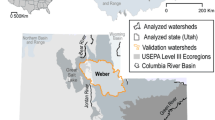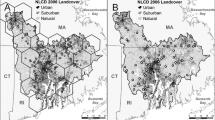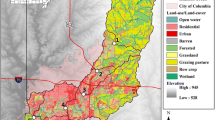Abstract
Riparian areas represent dynamic spatial gradients characterized by a varying degree of terrestrial–aquatic interaction. Many studies have considered riparian zones to be discrete watershed sub-portions (e.g., 100-m riparian buffers), whereas I introduce ‘zones of influence’ that are subsets of the riparian zone. The purpose of this study is to introduce the concept of hydrologically defined influence zones using a simple hydrologic model to delimit land-cover. I describe a method for identifying zones of influence using watershed hydrologic patterns to delimit zones along a near-stream continuum between a downstream point (e.g., sample reach) and the watershed boundary. Using hydrologic modeling equations and GIS, travel time was calculated for every 30 × 30-m cell in 10 watersheds providing spatially explicit estimates of watershed hydrology and enabling us to calculate the travel time required for rainfall in any watershed cell to reach the watershed terminus. Shorter-duration travel times (i.e., 30–60 min) described smaller areas than longer-duration travel times (i.e., 210–300 min). This method is an alternative method to delimit near stream areas when quantifying watershed influence.



Similar content being viewed by others
References
Apan, A. A., S. R. Raine & M. S. Paterson, 2002. Mapping and analysis of changes in the riparian landscape structure of the Lockyer Valley catchment. Queensland, Australia. Landscape and Urban Planning 59: 43–57.
Basnyat, P., L. D. Teeter, K. M. Flynn & B. G. Lockaby, 1999. Relationships between landscape characteristics and nonpoint source pollution inputs to coastal estuaries. Environmental Management 23: 539–549.
Boothroyd, I. K. G., J. M. Quinn, E. R. Langer, K. J. Costly & G. Steward, 2004. Riparian buffers mitigate effects of pine plantation logging on New Zealand streams 1. Riparian vegetation structure, stream geomorphology, and periphyton. Forest Ecology and Management 194: 199–213.
Burcher, C. L., H. M. Valett & E. F. Benfield, 2007. The land-cover cascade: Land-cover influences stream biota through a series of intermediate cause-effect couples. Ecology 88: 228–242.
Committee of Scientists (COS), 1999. Sustaining the People’s Lands: Recommendations for Stewardship of the National Forests and Grasslands into the Next Century. U.S. Department of Agriculture, Washington, DC.
Croke, J., P. Hairsine & P. Fogarty, 1999. Runoff generation and re-distribution in logged eucalyptus forests, south-eastern Australia. Journal of Hydrology 216: 56–77.
Decamps, H., M. Fortune, F. Gazelle & G. Pautou, 1988. Historical influence of man on the riparian dynamics of a fluvial landscape. Landscape Ecology 1: 63–73.
EPA (United States Environmental Protection Agency), 2000. Multi-Resolution Land Characteristics Consortium (MRLC) database. [http://www.epa.gov/mrlcpage]
Federal Interagency Working Group (FIWG), 1998. Stream Buffer Restoration. Principles, Processes, and Practices. National Technical Information Service, U.S. Department of Commerce, Washington, DC.
Friedman, J. M., W. R. Osterkamp & W. M. Lewis, 1996. Channel narrowing and vegetation development following a Great Plains flood. Ecology 77: 2167–2181.
Gomi, T., R. C. Sidle & J. S. Richardson, 2002. Understanding processes and downstream linkages of headwater systems. BioScience 52: 905–916.
Gordon, N. D., T. A. McMahon, B. L. Finlayson, C. J. Gippel & R. J. Nathan, 2004. Stream Hydrology. An Introduction for Ecologists, 2nd ed. Wiley, West Sussex, England.
Gregory, S. C., F. J. Swanson, W. A. McKee & K. W. Cummins, 1991. An ecosystem perspective of riparian zones. BioScience 42: 540–541.
Gupta, R. S., 1995. Hydrology and Hydraulic Systems. Waveland Press, Chicago.
Harding, J. S., E. F. Benfield, P. V. Bolstad, G. S. Helfman & E. B. D. Jones III, 1998. Stream biodiversity: The ghost of land use past. Proceedings of the National Academy of Sciences 95: 14843–14847.
Homer, C. G., C. Huang, L. Yang & B. Wylie, 2002. Development of a Circa 2000 Landcover Database for the United States. ASPRS Proceedings, April, 2002. Washington, DC
Hyatt, T. L., T. Z. Waldo & T. J. Beechie, 2004. A watershed scale assessment of riparian forests, with implications for restoration. Restoration Ecology 12: 175–183.
Karr, J. R. & I. J. Schlosser, 1978. Water resources and the land–water interface. Science 201: 229–234.
King, R. S., M. E. Baker, D. F. Whigham, D. E. Weller, T. E. Jordan, P. F. Kazyak & M. K. Hurd, 2005. Spatial considerations for linking watershed land cover to ecological indicators in streams. Ecological Applications 15: 137–153.
Lee, P., C. Smyth & S. Boutin, 2004. Quantitative review of riparian buffer width guidelines from Canada and the United States. Journal of Environmental Management 70: 165–180.
McKergow, L. A., I. P. Prosser, R. B. Grayson & D. Heiner, 2004. Performance of grass and rainforest riparian buffers in the wet tropics, far north Queensland. 1. Riparian hydrology. Australian Journal of Soil Research 42: 473–485.
Melesse, A. M. & W. D. Graham, 2004. Storm runoff prediction based on a spatially distributed travel time method utilizing remote sensing and GIS. Journal of the American Water Resources Association 40: 863–879.
Moglen, G. E. & E. R. Beighley, 2002. Spatially explicit hydrologic modeling of land use change. Journal of the American Water Resources Association 38: 241–253.
Molnar, P., P. Burlando & W. Ruf, 2002. Integrated catchment assessment of riverine landscape dynamics. Aquatic Sciences 64: 129–140.
Montgomery, D. R., 1999. Process domains and the river continuum. Journal of the American Water Resources Association 35: 397–410.
Montgomery, D. R. & L. H. MacDonald, 2002. Diagnostic approach to stream channel assessment and monitoring. Journal of the American Water Resources Association 38: 1–16.
Moore, R. D. & J. S. Richardson, 2003. Progress towards understanding the structure, function, and ecological significance of small stream channels and their riparian zones. Canadian Journal of Forest Research 33: 1349–1351.
Naiman, R. J., H. Décamps & M. E. McClain, 2005. Riparia. Academic Press, San Diego.
Naiman, R. J., K. L. Fetherston, S. McKay & J. Chen, 2001. Riparian forests. In Naiman, R. J. & R. E. Bilby (eds), River Ecology and Management: Lessons from the Pacific Coastal Region. Springer-Verlag, New York: 289–323.
National Resources Council (NRC), 2002. Riparian Areas: Functions and Strategies for Management. National Academy Press, Washington DC.
Paringit, E. C. & K. Nadaoka, 2003. Sediment yield modeling for small agricultural catchments: Land-cover parameterization based on remote sensing data analysis. Hydrologic Processes 17: 1845–1866.
Postel, S. L., G. C. Daily & P. R. Ehrlich, 1996. Human appropriation of renewable freshwater. Science 271: 785–788.
Reed, T. & S. R. Carpenter, 2002. Comparisons of P-yield, riparian buffer strips, and land cover in six agricultural watersheds. Ecosystems 5: 568–577.
Roth, N. E., J. D. Allan & D. L. Erickson, 1996. Landscape influences on stream biotic integrity assessed at multiple spatial scales. Landscape Ecology 11: 141–156.
Saunders, W., 2000. Preparation of DEM’s for use in environmental modeling analysis. In Maidment, D. R. & D. Dojic (eds), Hydrologic and Hydraulic Modeling Support with GIS. ESRI Press, Redlands, CA.
Smart, R. P., C. Soulsby, M. S. Cresser, A. J. Wade, J. Townend, M. F. Billett & S. Langan, 2001. Riparian zone influence on stream water chemistry at different spatial scales: A GIS-based modeling approach, an example for the DEE, NE Scotland. The Science of the Total Environment 280: 173–193.
Smock, L. A., J. E. Gladden, J. L. Riekenberg, L. A. Smith & C. R. Black, 1992. Lotic macroinvertebrate production in 3 dimensions—channel surface, hyporheic, and floodplain environments. Ecology 73: 876–886.
Sponseller, R. A. & E. F. Benfield, 2001. Appalachian headwater streams: Multiple-scale analysis. Journal of the North American Benthological Society 20: 44–59.
Stanford, J. A., 1998. Rivers in the landscape: Introduction to the special issue on riparian and groundwater ecology. Freshwater Biology 40: 402–406.
Steiner, F., S. Pieart, E. Cook, J. Rich & V. Coltman, 1994. State wetlands and riparian area protection programs. Environmental Management 18: 183–201.
Townsend, C. R., S. Doledec, R. Norris, K. Peacock & C. Arbuckle, 2003. The influence of scale and geography on relationships between stream community composition and landscape variables: Description and prediction. Freshwater Biology 48: 768–785.
Trimble, S. W. & P. Crosson, 2000. U.S. soil erosion rates: Myths and reality. Science 289: 248–250.
United States Army Corps of Engineers (USACE), 2000. Hydrologic Modeling System HEC-HMS Users Manual, Version 2.0. Hydrologic Engineering Center, U.S. Army Corps of Engineers, Davis, CA.
Van Nieuwenhuyse, E. E., 2005. Empirical model for predicting a catchment-scale metric of surface water transit time. Canadian Journal of Fisheries and Aquatic Sciences 62: 492–504.
Vannote, R. L., G. W. Minshall, K. W. Cummins, J. R. Sedell & C. E. Cushing, 1980. The river continuum concept. Canadian Journal of Fisheries and Aquatic Sciences 37: 130–137.
Van Sickle, J. & C. B. Johnson, 2008. Parametric distance weighting of landscape influence on streams. Landscape Ecology 23: 427–438.
Vidon, P. G. F. & A. R. Hill, 2004. Landscape controls on the hydrology of stream riparian zones. Journal of Hydrology 292: 210–228.
Walling, D. E., 1998. Erosion and sediment yield research—some recent perspectives. Journal of Hydrology 100: 113–141.
Wang, X. & Z. Yin, 1997. Using GIS to assess the relationship between landuse and water quality at a watershed level. Environment International 23: 103–114.
Ward, J. V., 1989. The 4-dimensional nature of lotic ecosystems. Journal of the North American Benthological Society 8: 2–8.
Wiens, J. A., 2002. Riverine landscapes: Taking landscape ecology into the water. Freshwater Biology 47: 401–415.
Woessner, W. W., 2000. Stream and fluvial plain ground water interactions: Rescaling hydrogeologic thought. Groundwater 38: 423–429.
Yin, Z. & X. Wang, 1999. A cross-scale comparison of drainage basin characteristics derived from digital elevation models. Earth Surface Processes and Landforms 24: 557–562.
Zelinski, J. & L. Quackenbush., 1999. An A-priori Approach to Hyperspectral Image Acquisition and Analysis. Commercial Remote Sensing Program Office. National Aeronautics and Space Administration. John C. Stennis Space Center, MS 39529.
Acknowledgments
This research was supported by the National Science Foundation Grand DEB-9632854 to the Virginia Tech Coweeta LTER. I would like to thank P. L. Angermeier, A. Braccia, E. N. J. Brookshire, J. R. Voshell, Jr., J. R. Webster, and R. H. Wynne for comments on earlier drafts.
Author information
Authors and Affiliations
Corresponding author
Additional information
Handling editor: K. Martens
Rights and permissions
About this article
Cite this article
Burcher, C.L. Using simplified watershed hydrology to define spatially explicit ‘zones of influence’. Hydrobiologia 618, 149–160 (2009). https://doi.org/10.1007/s10750-008-9572-0
Received:
Revised:
Accepted:
Published:
Issue Date:
DOI: https://doi.org/10.1007/s10750-008-9572-0




